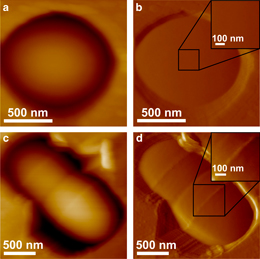Research Abstract
Lactococcus lactis生細胞中のペプチドグリカンのナノスケール組織化状態を可視化する
細菌細胞壁の主要な構成因子であるペプチドグリカンの空間組織化は、微生物学における重要な問題だが、いまだに明らかにされていない。本論文では、原子間力顕微鏡と細胞壁に変異の生じた細菌株の組み合わせが、生きているグラム陽性細菌の細胞壁ペプチドグリカンのナノスケール構造を調べるための強力な基盤となることを示す。
Imaging the nanoscale organization of peptidoglycan in living Lactococcus lactis cells
2010年6月15日 Nature Communications 1 : 27 doi: 10.1038/ncomms1027

細菌細胞壁の主要な構成因子であるペプチドグリカンの空間組織化は、微生物学における重要な問題だが、いまだに明らかにされていない。本論文では、原子間 力顕微鏡と細胞壁に変異の生じた細菌株の組み合わせが、生きているグラム陽性細菌の細胞壁ペプチドグリカンのナノスケール構造を調べるための強力な基盤と なることを示す。凹凸像から、Lactococcus lactis野生株細胞の表面は滑らかで特徴のない形態だが、細胞壁の細胞外多糖を 欠く変異株では、幅25 nmの帯が細胞の短軸に平行な方向に並ぶという周期構造がみられることがわかった。さらに、単分子認識画像化法を使って、平行な帯はペプチドグリカンから なることが示された。今回の結果は、生きているovococcusについて初めて得られたもので、細胞の長軸に垂直な平面中の細胞壁構造の特徴を論じるも のである。ここで示したような生細胞の非侵襲的観察実験は、グラム陽性細菌のペプチドグリカンの構造と組織化を解明する新しい方法となるだろう。
- ルーヴァンカトリック大学(ベルギー)
The spatial organization of peptidoglycan, the major constituent of bacterial cell-walls, is an important, yet still unsolved issue in microbiology. In this paper, we show that the combined use of atomic force microscopy and cell wall mutants is a powerful platform for probing the nanoscale architecture of cell wall peptidoglycan in living Gram-positive bacteria. Using topographic imaging, we found that Lactococcus lactis wild-type cells display a smooth, featureless surface morphology, whereas mutant strains lacking cell wall exopolysaccharides feature 25-nm-wide periodic bands running parallel to the short axis of the cell. In addition, we used single-molecule recognition imaging to show that parallel bands are made of peptidoglycan. Our data, obtained for the first time on living ovococci, argue for an architectural feature of the cell wall in the plane perpendicular to the long axis of the cell. The non-invasive live cell experiments presented here open new avenues for understanding the architecture and assembly of peptidoglycan in Gram-positive bacteria.

